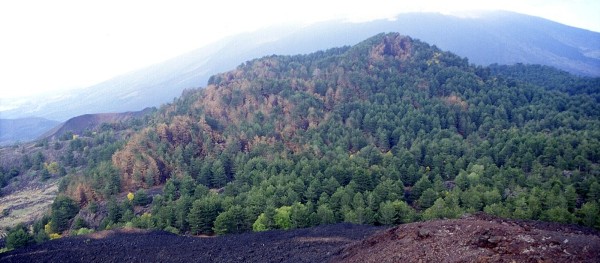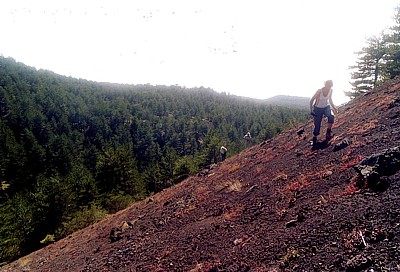| Etna
index |
||
| Geology | Geological history | Cones and craters |
| Eruptive characteristics | Eruptions before 1971 | Eruptions since 1971 |
| Etna and Man | References | Web sites |
| Weather forecasts | FAQ | Latest news |
 |
Clad
with dense forest, the large prehistoric cone of Monte Rosso on
Etna's west flank reveals little of its volcanic nature, except
for the irregular outline of its summit crater that is open toward
west. Several smaller knobs lying on the lower west (foreground
left) flank of the cone may be actually smaller cones built on
the same eruptive fissure on which Monte Rosso was built. The
small horseshoe-shaped cone of Monte
Mezzaluna, possibly formed in 1763, is seen at the north (left)
base of Monte Rosso, and Etna's main edifice, partly hidden by
clouds, lies in the background. Photograph taken from the summit
of Monte Di Fiore I (1974
eruption) in early July 1999 |
Mamma
Etna's countless children
Monte Rosso
W flank, 14.93674° E, 37.74428° N
Summit elevation: 1878 m (SE crater rim)
![]()
"Monte
Rosso" is a name that has been applied to several of Etna's flank
cones (in the case of the spectacular cone formed in 1669 near Nicolosi,
on the southern flank of the volcano, we also find the plural form, "Monti
Rossi"). Who understands Italian knows that this means "red
mountain" (or "red mountains", in the case of the Monti
Rossi), but actually "rosso" is a corruption of the word "grosso",
which means big. Monte Grosso is thus the BIG mountain, and in the case
of the Monte Rosso on the western flank of Etna this is truly justified.
This cone rises more than 150 m above its western base and stands still
80 m above the SE base, which lies in a saddle separating Monte Rosso
from another large cone, Monte Capre.
Monte Rosso is fairly densely vegetated but maintains a relatively youthful
shape. Its crater is horseshoe-shaped and open to the west, its rim being
highest on its southeastern side, which gives a strongly asymmetrical
shape to the cone. A lower hill lies at the lower end of the crater, marking
the site of the main effusive vent of the eruption that produced Monte
Rosso - a constitution seen at many of Etna's flank cones including those
formed during recent eruptions.
Although I climbed nearby Monte Mezzaluna
already in April 1997, my first visit to the summit of Monte Rosso was
only in September 2003, involving a strenuous climb up the steep and poorly
vegetated northeastern side of the cone (the sparse vegetation in this
area might be a consequence of the Monte
Mezzaluna eruption which probably occurred only a few hundred years
ago - possibly in 1763).
 |
Members
of an excursion group from the University of Utrecht (Netherlands)
are struggling their way up the painfully steep slope of Monte Rosso,
September 2003. The northeastern flank of the cone bears much less
vegetation than all other areas on the cone, which is possibly an
effect of the eruption of nearby Monte
Mezzaluna a few centuries ago. This allows spectacular panoramic
views of the surrounding landscape, whereas on the other sides of
the cone views are partially obstructed by the dense forest |
Copyright © Boris Behncke, "Italy's Volcanoes: The Cradle of Volcanology"
Page set up on 15 December 2003, last modified on 21 February 2004
